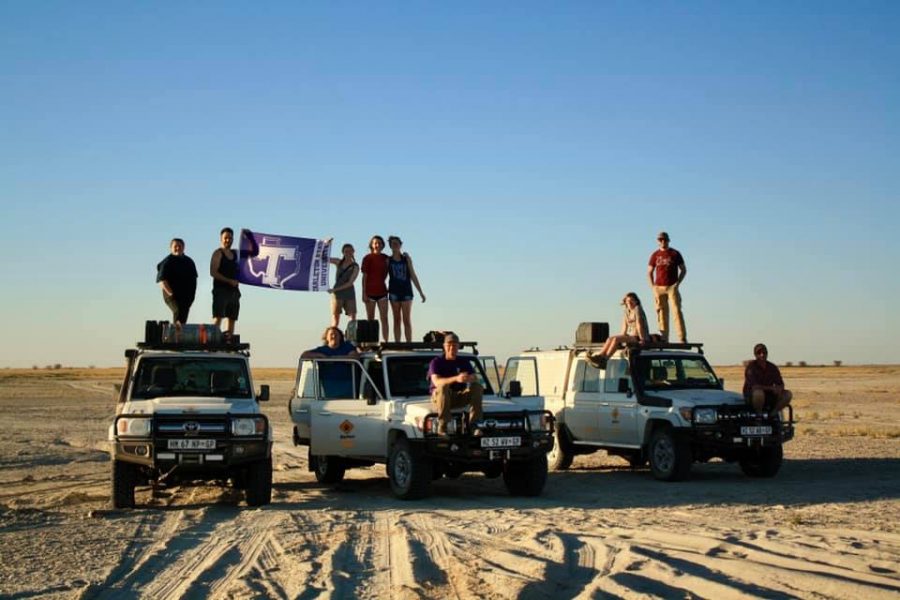Photo courtesy of Klaire Brock
The 2019 Southern Africa Study abroad trip group consisted of eight students, three graduate students and two professors. This photo was taken in the Nata Bird Sanctuary in Nata, Botswana.
Five countries in five weeks, this is Nata normal study abroad
During freshman orientation I heard about the Southern Africa Study Abroad trip available through Tarleton’s Department of Wildlife, Sustainability and Ecosystem Science and I knew I had to pursue this opportunity. This summer I went on this most amazing trip and it checked off so many boxes on my bucket list.
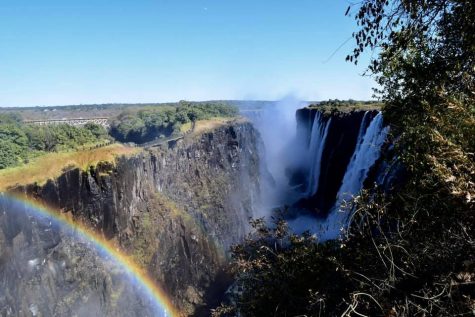
One of the Seven Natural Wonders of the World, Victoria Falls. The group spent three days in Zambia, some were able to go on excursions if they wanted to.
Most “Study Abroad” courses only focus on a particular country or culture or on a particular field of study. This course, by definition, has you on the move for more than a month as you loop through five countries in Southern Africa,which is an immense area to try to cover. There are so many things that make this study abroad trip special and unique. Just getting to travel and see five countries on one trip would be amazing but to visit world heritage sites (such as Soweto Township), to see one of the Seven Natural Wonders of the World (Victoria Falls) and opportunity to see and experience to Africa’s “Big Five” (Elephant, Rhinoceros, Lion, Leopard and Cape Buffalo) in their natural environment makes this study abroad truly an experience of a lifetime. Prior to going “Abroad,” there is a two-week introductory class on Africa, cultural expectations as well as the wildlife and birds you will encounter. The more you absorb, the more you will connect with what you will be seeing in Africa. The five week-long “Abroad” part visits national parks and preserves in five countries – South Africa, Botswana, Zimbabwe, Zambia and Namibia. The trip offers encounters with wildlife, and provides a deeper understanding of the value of these ecosystems as well as the cultures of the region’s people.
From the start, we learned to adapt, be flexible and patient which are all essential when traveling but are required to travel in Africa. If you go into an adventure like this, pack a positive attitude and know that things don’t always go according to plan – it will truly help you get the most out of the experience. The graduate student charged with getting us safely to Africa was unable to leave with us so our group of eight students flew “solo” on the long trip to Johannesburg, South Africa to meet up with Dr. Murray and Dr. Breeden who were already there getting our supplies ready.
A bonus start to our great adventure was the planned lay-over in London, England during which we students packed in an eight-hour whirlwind tour of the highlights of London. I had been to London before but had not seen it at that speed. It was a great way to begin getting to know the group we’d be spending the next 36 days with. It was also exhausting which is exactly what you need when you have to get back on a plane and fly 12 more hours – we slept.
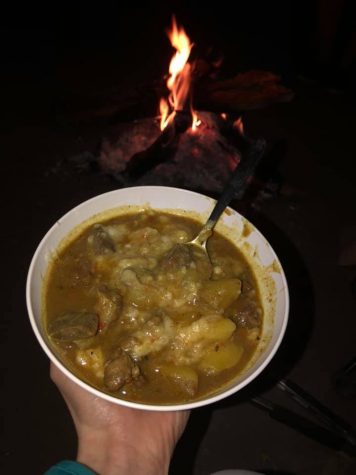
A big part of experiencing the Africa adventure was our accommodations which varied from rustic lodges to tents. The best way to picture it, is imagine being on a true safari. We had land rovers, which we drove ourselves, we crossed rivers, and we bought food supplies periodically along the way, set up the campsites, put up and took down our own tents, and built cooking fires. Several times we stayed within yards of watering holes where all kinds of animals came to drink in the evenings, including elephants, rhinoceros, giraffe and zebras. We often ate wild game and tried the food the regional culture had to offer. Whenever we were tent camping we’d cook our own food so we became very comfortable cooking over an open fire. I’m not the most adventurous eater but I learned to tolerate eating wild game include Kudo (a kind of deer).
There were so many moments of stunning beauty…colorful birds, incredible sunsets, and unique trees like the Baobab. I have a passion for photography and took over 3,000 photos. I still can’t believe I was able to experience and photograph it all. One “out of National Geographic” moment was watching the flamingos set flight in the Nata Bird Sanctuary in Nata, Botswana. I also especially enjoyed visiting the Hoedspruit Endangered Species Center where they rescue and rehabilitate injured animals and where we got to be very close to cheetahs and painted dogs.
After setting up at campsites, we had scheduled hikes or drives through the park areas to observe birds and hoped to chance upon other wildlife. We often encountered hyenas, baboons, kudu, zebras, elephants, impalas and a huge variety of birds. In one day we saw many of the most recognized African mammals at the same watering hole and once were witness to the “circle of life” as predators took turns eating prey. It was surreal to stop your vehicle to watch a group of rhinoceros or baboons just cross the road in front of you or watch a herd of elephants wash a baby at a watering hole or a herd of hippos sunbathing at the edge of a river.
Sometimes when we were tent camping, we’d set up night-vision game cameras around the perimeter of the campsite to see what wildlife came close while we were sleeping. In Zimbabwe we saw that a huge male lion wandered just 30 feet away from our tent. Yikes, but so cool! Most people will never see even one of the “Big Five” in their natural habitat but we amazingly saw ALL Five. There were truly breath-taking experiences none of us will ever forget.
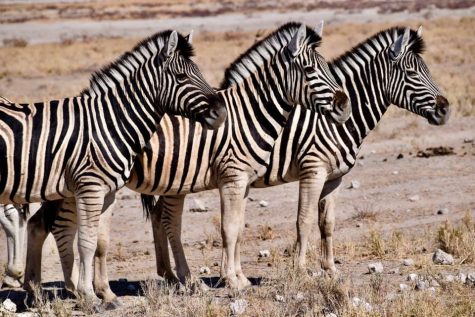
During this study abroad trip, the group saw thousands of Plains Zebra, each of them with unique stripes since no zebra has the same stripes.
An unforgettable moment was when I got to drive in Etosha National Park on our last game drive. Suddenly my friend Daniel yelled, “Leopard!” I slammed on the brakes and threw the vehicle into reverse, so we could try to find it again. For some crazy reason, we decided that climbing on top of the vehicle would be the best way to get a photo of a wild leopard. So we all got out on top to look and after a bit we watched the leopard just wander out the brush right next to us. That moment with the leopard allowed us to check off having experienced the last of our Africa’s “Big Five” while on our last game drive.
In addition to amazing experience of seeing wildlife in their natural environment, we also had opportunities to do some really incredible and adventurous things. I took a micro-flight over Victoria Falls, Kenya, experiencing its power and stunning beauty from high, high above. I parachuted over the oldest desert in the world in Namibia – I was terrified but glad I did it especially since there were no trees around to land on. And I “kind-of” learned to drive a stick-shift land rover and got to drive in African national parks. These were just some many experiences that I will cherish and remember my whole life.
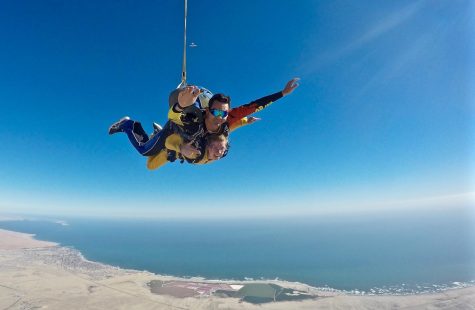
Klaire Brock showing Texan pride while skydiving in Swakopmund, Namibia.
It is hard to describe all that you will “learn” if you chose this study abroad opportunity. It is so much more than a course to learn about wildlife and sustainability. It is truly a “life” experience. With a positive and flexible attitude, a camera and a very efficiently packed dufflebag, the Southern Africa Study Abroad experience will change your life. I would love to be back in that land rover driving across Africa and looking for the next unexpected and beautiful scene or creature to photograph. To quote Hemmingway “If I have ever seen magic, it has been in Africa.”

